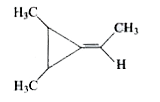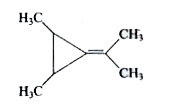Which of the following will not show geometrical isomerism?
Ph−N=N−Ph
2,4− Dinitro phenyl hydrazone of acetone
Oxime of formaldehyde
Cyclohexan 1,2− diol
The correct Answer is:B, C
To determine which of the given compounds will not show geometrical isomerism, we will analyze each option one by one.
1. Identify the first compound: pH=N-pH (Phenyl double bond to Phenyl)
- This compound has a double bond between two phenyl groups.
- Since each phenyl group can be on the same side (cis) or opposite sides (trans) of the double bond, this compound can show geometrical isomerism.
- Conclusion: This compound shows geometrical isomerism.
2. Identify the second compound: 2,4-dinitrophenylhydrazone of acetone
- The structure of this compound includes a double bond between the carbon of the acetone and the nitrogen of the hydrazone.
- In this case, the two groups attached to the nitrogen are both nitro groups (2,4-dinitro), and the other side has a methyl group from acetone.
- Since there are two identical groups (nitro groups) across the double bond, this compound cannot show geometrical isomerism.
- Conclusion: This compound does not show geometrical isomerism.
3. Identify the third compound: Oxime of formaldehyde
- The oxime of formaldehyde has the structure R1C=N-OH, where R1 is a hydrogen atom.
- Here, both groups across the double bond (C=N) are the same (both are hydrogen atoms).
- Since there are two identical groups (hydrogens) across the double bond, this compound cannot show geometrical isomerism.
- Conclusion: This compound does not show geometrical isomerism.
4. Identify the fourth compound: Cyclohexane 1,2-Diol
- The structure of Cyclohexane 1,2-Diol has two hydroxyl (OH) groups attached to adjacent carbon atoms in a cyclic structure.
- This compound can exist in two forms: one where both OH groups are on the same side (cis) and one where they are on opposite sides (trans).
- Therefore, this compound can show geometrical isomerism.
- Conclusion: This compound shows geometrical isomerism.
Final Answer:
The compounds that do not show geometrical isomerism are:
- Option B: 2,4-dinitrophenylhydrazone of acetone
- Option C: Oxime of formaldehyde
- This compound has a double bond between two phenyl groups.
- Since each phenyl group can be on the same side (cis) or opposite sides (trans) of the double bond, this compound can show geometrical isomerism.
- Conclusion: This compound shows geometrical isomerism.
- The structure of this compound includes a double bond between the carbon of the acetone and the nitrogen of the hydrazone.
- In this case, the two groups attached to the nitrogen are both nitro groups (2,4-dinitro), and the other side has a methyl group from acetone.
- Since there are two identical groups (nitro groups) across the double bond, this compound cannot show geometrical isomerism.
- Conclusion: This compound does not show geometrical isomerism.
- The oxime of formaldehyde has the structure R1C=N-OH, where R1 is a hydrogen atom.
- Here, both groups across the double bond (C=N) are the same (both are hydrogen atoms).
- Since there are two identical groups (hydrogens) across the double bond, this compound cannot show geometrical isomerism.
- Conclusion: This compound does not show geometrical isomerism.
- The structure of Cyclohexane 1,2-Diol has two hydroxyl (OH) groups attached to adjacent carbon atoms in a cyclic structure.
- This compound can exist in two forms: one where both OH groups are on the same side (cis) and one where they are on opposite sides (trans).
- Therefore, this compound can show geometrical isomerism.
- Conclusion: This compound shows geometrical isomerism.
The compounds that do not show geometrical isomerism are:
- Option B: 2,4-dinitrophenylhydrazone of acetone
- Option C: Oxime of formaldehyde
Topper's Solved these Questions
- BOOK - CENGAGE CHEMISTRY ENGLISHCHAPTER - ISOMERISMEXERCISE - Single correct answer type13videos
ISOMERISM
- BOOK - CENGAGE CHEMISTRY ENGLISHCHAPTER - ISOMERISMEXERCISE - Single correct answer type (Exercise)65videos
ISOMERISM
- BOOK - CENGAGE CHEMISTRY ENGLISHCHAPTER - ISOMERISMEXERCISE - (Linked Comprehension Type)Exercise13videos
ISOMERISM
- BOOK - CENGAGE CHEMISTRY ENGLISHCHAPTER - IONIC EQUILIBRIUMEXERCISE - Archives Subjective28videos
IONIC EQUILIBRIUM
- BOOK - CENGAGE CHEMISTRY ENGLISHCHAPTER - NCERT BASED EXERCISEEXERCISE - Chemical Equilibrium73videos
NCERT BASED EXERCISE
Similar Questions
Knowledge Check
- Question 1 - Select One
Which of the following will not show optical isomerism ?
ACl−CH=C=CH−ClBBr−CH=C=CH−BrC D
D
- Question 2 - Select One
Which of the following will not show optical isomerism as well as geometrical isomerism ?
A B
B C
C D
D
Which of the following cannot show geometrical isomerism
View SolutionWhich of the following will not show optical isomerism?
View SolutionOne among the following will not show geometrical isomerism
View SolutionWhich of the following can show geometrical isomerism?
(i) Propene (ii) But-1-ene (iii) But-2-ene (iv) Pent-2-eneView SolutionWhich of the following will exhibit geometrical isomerism?
View SolutionWhich of the following can show geometrical isomerism?
View Solution

